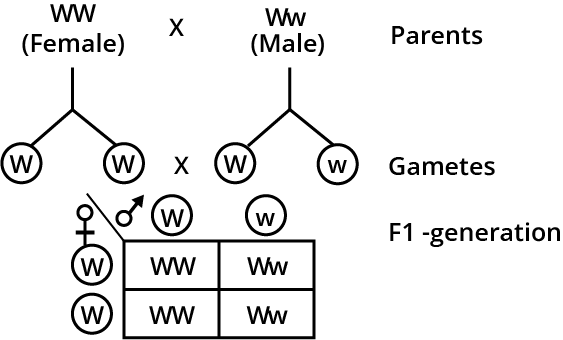Biology Class 12 Principles of Inheritance and Variation NCERT Solutions - FREE PDF Download






Related Chapters























FAQs on NCERT Solutions for Class 12 Biology Chapter 4 Principles of Inheritance and Variation
1. What Does NCERT Solutions for Chapter 4, Class 12 Biology Principles of Inheritance and Variation consist of?
Chapter 4, class Principles of Inheritance and Variation NCERT solutions, is about Gregor Mendel’s experiment with pea plants and continues on with the Punnett square. Detailed explanations are provided on the applications of Punnett’s square. Also, it elaborates on the inheritance of one gene and two genes. The chapter explains the concepts of recessive and dominant genes. Going forward, it covers explanations of genetic mutations and sex determination. Students can also refer to the PDF's Principles of Inheritance and variation questions and answers. This will help them get a clear idea of the topics covered.
2. How to Prepare for Principles of Inheritance and Variation using Chapter 4 Biology Class 12 NCERT solutions?
Preparation for principles of inheritance and variation must include a complete knowledge of the text. Following that, any student must solve the questions given in the exercise. They can refer to Chapter 4 Biology Class 12 NCERT solutions if they face any issues. This will help them with their preparation. Also, after studying the chapter at least three times, students can refer to class 12 biology chapter 4 PDF and past year question papers and sample papers. This will help them better understand the topic and the type of questions that are likely to be asked.
3. What are alleles?
An allele is a variant form of a particular gene. Alleles exist in pairs and occupy a specific location on a particular chromosome. Different versions of these genes are responsible for controlling a single specific trait in the organism and produce either a dominant or a recessive effect for it in them. One very common example of an allele about the human blood group AB.
4. What are the important topics of NCERT Solutions for Class 12 Biology Chapter 4, Principles of Inheritance and Variation?
The major topics covered in the Class 12 Biology Chapter 4 NCERT textbook are as follows:
Mendel’s Experiment,
Reason For Selecting Pea Plants
Genes And Alleles,
Homozygous And Heterozygous
Dominant And Recessive Genes
Mono And Dihybrid Crosses
Inheritance And Variation
Determination Of The Number Of Gametes For A Diploid Organism
Test Cross, And Monohybrid Cross
Punnett Square
Passing Of Traits From Parents To Offspring
Trait Combinations
5. How do you download Class 12 Biology Chapter 4 Principles of Inheritance and Variation class 12 NCERT PDF?
If you want to download CBSE Class 12 NCERT Biology PDF Solutions, you can
follow these steps:
Visit the page NCERT Solutions for Class 12 Biology and choose Chapter 4.
The next page will contain a list of exercises. Find the one for which you want the
solution and click on it.
It will redirect you to the next page where you will find the link to download.
6. Is Vedantu enough for Class 12 Biology Chapter 4 Principles of Inheritance and Variation NCERT questions?
Vedantu is a trusted site for your study materials. Here, you are going to find the most accurate solutions to all your problems. These solutions follow the CBSE pattern and hence, they will prepare you to frame answers for your board examinations in such a way that you don’t end up losing marks. Vedantu has a team of experts who carefully analyse and develop these solutions for you. The resources are available at free of cost on the Vedantu app and on the Vedantu website.
7. What is the basis of inheritance and variation?
The basis of inheritance is the passing of traits from one generation to the next, whereas variation gives differences between individuals within a species.
8. What is the biggest advantage of inheritance?
The advantages of inheritance are as follows:
Pre-existing inheritance quality
Efficiency in passing on traits
Maintaining complex traits
Reduced Errors
Survival and adaptation
9. What is the simple definition of inheritance?
In simple terms, inheritance means getting some instructions from your parents, which can be written in a special code using DNA. To get more details and understand the concepts related to the principles of inheritance and variation, students can refer to class 12 biology chapter 4 PDF.
10. What is the chromosomal basis of inheritance?
The chromosomal basis of inheritance explains how traits are inherited from parents to offspring. The chromosomal theory explains inheritance and variation clearly, making the understanding of genetics and heredity effective.





